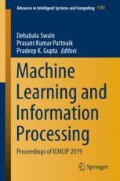Abstract
In today’s era of advanced forensic and security technologies, the problem of identifying a human face from a low-quality image obtained from low-quality hardware or other reasons is a major challenge. Trying to extract meaningful information from these images is very difficult. These low-quality images have mainly two kinds of distortion in it, i.e. blurring and pixelation. Prior attempts have been done using different machine learning and deep learning techniques, but the desired high-quality images are not obtained. In this paper, we have used the conditional adversarial network to reconstruct highly obfuscated human faces. Various previous works on the conditional adversarial network have suggested it as a general-purpose solution for image-to-image translation problems. The conditional adversarial network is able to learn mapping from the provided input image to resulting output image. It is also able to learn the loss function to train the mapping. We have examined the result of this model using pixel loss function which gives the exact mapping of obtained high-quality human face with ground truth; furthermore, we have examined the capabilities of this model with very high-level obfuscated images.
Access this chapter
Tax calculation will be finalised at checkout
Purchases are for personal use only
References
Lander, K., and L. Chuang. 2005. Why are moving faces easier to recognize? Visual Cognition 12 (3): 429–442.
Lander, K., V. Bruce, and H. Hill. 2001. Evaluating the effectiveness of pixelation and blurring on masking the identity of familiar faces. Applied Cognitive Psychology 15 (1): 101–116.
Gross, R., L. Sweeney, F. de la Torre, and S. Baker. 2006. Model-based face de-identification. In 2006 Conference on Computer Vision and Pattern Recognition Workshop (CVPRW’06), 161–161, June 2006.
McPherson, R., R. Shokri, and V. Shmatikov. 2016. Defeating image obfuscation with deep learning. CoRR, abs/1609.00408.
Yang, C.-Y., C. Ma, and M.-H. Yang. 2014. Single-image superresolution: A benchmark. In Proceedings of European Conference on Computer Vision.
Radford, A., L. Metz, and S. Chintala. 2016. Unsupervised representation learning with deep convolutional generative adversarial networks. ICLR 2 (3): 16.
Ioffe, S., and C. Szegedy. 2015. Batch normalization: Accelerating deep network training by reducing internal covariate shift. ICML 3: 4.
Pathak, D., P. Krahenbuhl, J. Donahue, T. Darrell, and A.A. Efros. Context encoders: Feature learning by inpainting. In CVPR, 2, 3, 13, 17.
Wang, X., and A. Gupta. 2016. Generative image modeling using style and structure adversarial networks. ECCV 2 (3): 5.
Johnson, J., A. Alahi, and L. Fei-Fei. 2016. Perceptual losses for real-time style transfer and super-resolution. ECCV 2: 3.
Zhou, Y., and T.L. Berg. 2016. Learning temporal transformations from time-lapse videos. ECCV 2 (3): 8.
Yoo, D., N. Kim, S. Park, A.S. Paek, and I.S. Kweon. 2016. Pixellevel domain transfer. ECCV 2: 3.
Hinton, G.E., and R.R. Salakhutdinov. 2006. Reducing the dimensionality of data with neural networks. Science 313 (5786): 504–507.
Ronneberger, O., P. Fischer, and T. Brox. 2015. U-net: Convolutional networks for biomedical image segmentation. MICCAI 2: 3.
Author information
Authors and Affiliations
Corresponding author
Editor information
Editors and Affiliations
Rights and permissions
Copyright information
© 2020 Springer Nature Singapore Pte Ltd.
About this paper
Cite this paper
Rajgure, S., Mahat, M., Mekhe, Y., Lade, S. (2020). Reconstructing Obfuscated Human Faces with Conditional Adversarial Network. In: Swain, D., Pattnaik, P., Gupta, P. (eds) Machine Learning and Information Processing. Advances in Intelligent Systems and Computing, vol 1101. Springer, Singapore. https://doi.org/10.1007/978-981-15-1884-3_9
Download citation
DOI: https://doi.org/10.1007/978-981-15-1884-3_9
Published:
Publisher Name: Springer, Singapore
Print ISBN: 978-981-15-1883-6
Online ISBN: 978-981-15-1884-3
eBook Packages: Intelligent Technologies and RoboticsIntelligent Technologies and Robotics (R0)

